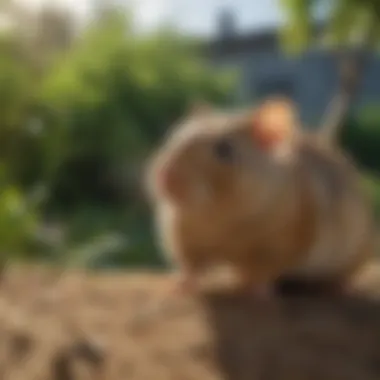Corky's Rodent Control: Innovative Pest Management Solutions


Intro
Rodent control is crucial in maintaining a safe and healthy living environment. Corky's Rodent Control is a reputable service that focuses on effective methodologies for managing rodent infestations. This article will go through some key subjects concerning rodent control, including identification of common pests, prevention techniques, and eco-friendly pest control options.
Understanding these aspects is essential for homeowners who want to protect their houses from potential damage and health risks associated with rodents. As we explore the specifics of Corky's approach, readers will gain insights that can be easily applied in daily life for maintaining pest-free homes.
Identification of Common Pests
Description of Common Pests
Rodents are amongst the most common pests found in urban and suburban areas. They can cause damage to property and pose health risks. The common types of rodents encountered include:
- House Mouse: Small, with a pointed snout and large ears. They are often found in houses, seeking food and warmth.
- Norway Rat: Larger than the house mouse, with a robust body and a blunt snout. They prefer burrowing and are commonly found outdoors.
- Roof Rat: Similar in size to the Norway rat but with a more slender body and longer tail. They are known for nesting in higher locations, such as attics.
Each of these pests can bring unique challenges when it comes to control and management.
Signs of Infestation
Recognizing the signs of a rodent infestation early is vital. Look out for:
- Droppings: Small, dark pellets often found in areas where food is stored or around nests.
- Gnaw Marks: Rodents tend to chew on various materials like wood, plastic, and wires.
- Nests: Shredded paper, fabric, or insulation can indicate a nesting site.
- Noises: Scratching or scurrying sounds, especially at night, may indicate rodent activity.
Prompt action can help mitigate the repercussions of an infestation.
Prevention Techniques
Creating a rodent-proof environment is fundamental. Here are effective prevention techniques to consider:
Home Maintenance Tips
- Seal Entry Points: Inspect and seal cracks and openings in walls, foundations, and around pipes.
- Proper Food Storage: Store food in airtight containers and keep kitchens clean to avoid attracting rodents.
- Limit Clutter: Reducing clutter provides fewer hiding spaces for rodents.
Environmental Modifications
- Yard Maintenance: Keep the lawn trimmed and remove debris that can serve as shelter for rodents.
- Proper Waste Disposal: Use secure trash bins to discourage foraging.
By implementing these tips, homeowners can greatly minimize the risk of rodent infestations in their homes.
Eco-Friendly Pest Control Options
Sustainability is an important aspect of modern pest management. Here are some eco-friendly pest control strategies:
Natural Pesticides
- Peppermint Oil: Known for its strong scent, applying peppermint oil can deter rodents effectively.
- Diatomaceous Earth: A natural powder that is safe for humans but can be harmful to insects and can deter pests when used properly.
Organic Pest Control Techniques
- Live Traps: Instead of harmful methods, consider using live traps to capture and release rodents away from your home.
- Boric Acid: While not a traditional pesticide, it can be used in moderation to manage rodent populations safely.
Corky’s Rodent Control approaches pest management with an emphasis on sustainable practices. This ultimately contributes to a healthier environment for everyone.
Prelims to Corky's Rodent Control
The management of rodent infestations has gained significant importance in both residential and commercial settings. Corky's Rodent Control offers a comprehensive approach to this growing concern. Understanding various aspects of this service allows homeowners and property managers to make informed decisions. In this section, we present an outline of the various offerings at Corky's, as well as the target audience that can benefit from their expertise.
Overview of Services
Corky's Rodent Control provides a broad range of services tailored specifically to address rodent issues. Their methodology starts with thorough inspections, identifying not just the presence of rodents but also potential entry points and breeding grounds. Here are some key services:
- Inspections: A detailed assessment of the area to identify signs of infestation and vulnerabilities.
- Exclusion Services: Sealing entry points to prevent future infestations.
- Trapping and Removal: Use of various rodent traps and safe removal techniques.
- Sanitation Advice: Guidelines on maintaining a clean environment to minimize attractants.
- Follow-up Monitoring: Regular check-ins to ensure rodent populations are managed effectively.
By using a combination of strategies, Corky's ensures an effective eradication of existing problems alongside measures to prevent re-infestation.


Target Audience and Reach
Corky's Rodent Control primarily targets homeowners and landlords who are dealing with infestation problems. But, its reach extends beyond residential properties. Their services are also relevant to businesses concerned about maintaining a pest-free environment. Potential customers include:
- Homeowners: Individuals seeking immediate solutions for rodent issues in their homes.
- Property Managers: Professionals maintaining multiple units where rodent infestations could disrupt tenant satisfaction.
- Small Business Owners: Retailers or food establishments needing to safeguard their reputation.
With a focus on effective solutions, Corky's helps a diverse audience address and manage their rodent concerns.
Understanding Rodent Infestations
Understanding rodent infestations is crucial for effectively managing pest control. It allows homeowners to gain insight into the behaviors and habits of common rodent species. This leads to more targeted and successful interventions. Recognizing the signs of an infestation early can minimize damage to properties and reduce health risks associated with rodent presence.
Types of Rodents Commonly Encountered
There are several types of rodents that are commonly encountered in residential areas. The most prevalent ones include:
- House Mouse: Small in size, with a range of colors from light brown to grey. They are known for their adaptability and rapid reproduction.
- Norway Rat: Larger than the house mouse, Norway rats have a robust body. They are typically gray and can cause significant damage due to their gnawing habits.
- Roof Rat: Slightly smaller than the Norway rat, roof rats are agile climbers and prefer areas above ground, such as attics.
- Field Mouse: These mice are usually found in rural areas but can invade homes in search of food.
Identifying the specific type of rodent involved in an infestation is essential for choosing the appropriate management strategy.
Signs of Rodent Presence
Recognizing the signs of rodent presence is key to timely action. Some common indicators include:
- Droppings: Small, dark pellets are often found near food sources or nesting areas.
- Gnaw Marks: Rodents continuously gnaw to keep their teeth trimmed. This damage might be apparent on wires, walls, or food packaging.
- Nests: Rodents create nests from shredded paper, fabric, or insulation materials, often found in hidden spots.
- Scurrying Noises: Noises in walls, ceilings, or attics, especially at night, indicate rodent activity.
Awareness of these signs can help homeowners take prompt action to control infestations.
Health Risks Associated with Rodents
Rodents pose significant health risks that cannot be overlooked. They can transmit diseases that affect humans and pets. Commonly known risks include:
- Leptospirosis: Spread through urine of infected rodents, this bacterial disease can cause severe health issues.
- Hantavirus: This virus can be transmitted through droppings or urine and may lead to respiratory problems.
- Salmonella: Rodents can contaminate food or surfaces, leading to foodborne illnesses.
Understanding these health risks emphasizes the need for effective rodent management strategies to protect yourself and your family.
Corky's Methodology
Corky's Rodent Control employs a systematic approach to pest management that integrates various strategies tailored to the specific needs of each environment. This methodology is crucial as it ensures the most effective solutions to rodent infestations while minimizing disruption to the homes and businesses they serve. Understanding Corky's approach allows homeowners to appreciate the depth of planning and execution involved in pest control.
Assessment and Inspection
The first step in Corky’s methodology is thorough assessment and inspection. This phase is vital for identifying the extent of the rodent infestation and pinpointing entry points. Professionals from Corky's conduct detailed walkthroughs of both residential and commercial spaces. They look for signs such as droppings, gnaw marks, and nests. Using tools like infrared cameras sometimes helps in detecting nests and burrows hidden from plain sight. The ability to accurately assess the issue is fundamental in forming an effective response plan.
Tailored Treatment Plans
Once an assessment is complete, Corky's develops tailored treatment plans that cater to the specific type of rodent and the conditions of the infestation. Each home has its unique characteristics, which means a one-size-fits-all approach is not sufficient. The customized plans may combine various methods such as trapping and baiting, depending on what the inspection revealed. This consideration of unique factors results in higher effectiveness and quicker results, significantly reducing the impact pests have on daily life.
Use of Eco-Friendly Solutions
Corky’s Rodent Control places a strong emphasis on the use of eco-friendly solutions. The team is aware of the health implications associated with traditional pest control methods, particularly with respect to children and pets. Consequently, they utilize methods and products that minimize harmful effects on the environment and the occupants of the building. Evidence-based tactics, like integrated pest management (IPM), guide their processes. By choosing green alternatives like biodegradable baits or traps that do not involve chemicals, Corky's reduces the risk associated with pest eradication while still achieving successful outcomes.
"Effective pest control doesn't have to come at the expense of safety or environmental health. Corky’s takes a responsible approach to managing rodent issues."
Incorporating eco-friendly strategies reflects not only a commitment to sustainable practices but also a modern understanding of pest management. These methods contribute to long-term solutions rather than quick fixes, ensuring a safer environment for all.
Preventative Measures in Rodent Control
Preventative measures in rodent control play a crucial role in managing infestations effectively. They go beyond just immediate responses to rodents and focus on minimizing the risk of future issues. Such approaches not only enhance the overall safety and comfort of living spaces but also significantly reduce the costs associated with extermination and repair. Understanding and implementing these measures can make a notable difference in a household's pest management strategy.
Structural Integrity Assessment
A thorough structural integrity assessment is the first step in effective rodent prevention. This involves a detailed examination of the building's foundation, walls, and roof. Potential entry points such as cracks or gaps should be identified and addressed. It is essential for homeowners to regularly check for any deterioration that may allow rodents to find shelter.
- Identify Vulnerabilities: Look for holes around pipes, vents, and wires. Small openings can be significant pathways for rodents.
- Seal Entry Points: Use materials like steel wool, caulk, or expanding foam to seal these areas. Ensure that these measures are durable enough to withstand gnawing.
- Regular Inspections: Schedule regular assessments to monitor the integrity of your structure. This proactive approach can save considerable costs on repairs and pest control services.


Sanitation Practices
Sanitation practices are equally important in rodent control. Cleanliness directly affects the likelihood of attracting rodents. Several habits can be adopted to maintain a pest-free environment:
- Proper Food Storage: Store food in airtight containers, and ensure that kitchens are free of crumbs or spills. This deprives rodents of easy access to food sources.
- Waste Management: Keep garbage in sealed bins and remove waste promptly. Rodents are opportunistic feeders; controlling waste is critical.
- Routine Cleaning: Regularly clean under appliances and furniture, where debris might accumulate unnoticed. A clean space reduces potential nesting sites for pests.
Implementing these practices consistently not only addresses current rodent problems but also helps deter future infestations.
Landscaping Considerations
Landscaping can influence rodent activity significantly. Homeowners should pay attention to their outdoor spaces to prevent attracting rodents:
- Trim Vegetation: Keep shrubs, trees, and plants well-trimmed and away from the house. Dense vegetation can provide shelter for rodents close to buildings.
- Mulch Wisely: Use mulch sparingly and ensure it does not encourage pests to hide near the foundation. Alternative landscaping materials may be considered.
- Remove Debris: Keep yards clean by removing piles of wood, leaves, and other materials that can serve as nesting sites.
Creating a hostile environment for rodents starts outside your home. Small adjustments can significantly impact pest management strategies.
These landscaping measures, when combined with structural and sanitation efforts, can form a comprehensive barrier against rodent infestations. Adopting a holistic approach to pest management helps maintain safer, cleaner, and more pleasant living conditions for everyone.
Effective Response Techniques
Effective response techniques are vital for managing rodent infestations. These strategies focus on immediate actions that address active rodent problems, which can prevent extensive property damage and health risks. Each technique proposes specific actions that can lead to successful rodent control, creating a safe, pest-free environment.
Trapping and Exclusion
Trapping is one of the most effective and humane methods for controlling rodent populations. When executed properly, traps can quickly reduce the number of rodents. There are two main types of traps: snap traps and live traps. Snap traps kill rodents instantly. On the other hand, live traps allow for the capture of rodents without harming them, enabling transport away from the property.
For maximum effectiveness, consider placement. Traps should be set along walls where rodent activity is most likely. It's crucial to check traps regularly to ensure captured rodents are dealt with promptly.
Exclusion helps prevent future infestations. This involves sealing entry points in homes or buildings. Common entry points include gaps around doors, windows, and utility openings. Some of the methods to reinforce these barriers include:
- Using steel wool to block holes.
- Installing door sweeps.
- Maintaining landscaping that does not encourage rodents.
Baiting Strategies
Baiting can complement trapping when dealing with a larger rodent population. Proper baiting involves choosing the right type of bait based on the target species. For instance, peanut butter may attract mice, while certain grains may be more successful for rats. It is important to place bread in areas where rodents are active.
Baits should be placed safely, away from pets and children. Using bait stations can restrict access, ensuring safety. As with traps, it’s essential to monitor bait levels consistently, replenishing as necessary. Baiting can yield results, but it should be part of a broader strategy that includes inspection and exclusion to be truly successful.
When to Seek Professional Help
In some cases, DIY methods may fall short. Homeowners should recognize the signs that indicate a need for professional assistance. If rodent activity persists despite efforts, or if signs of damage appear, it is time to contact experts.
Professional services offer advanced techniques and equipment that can lead to more effective results. They also provide thorough inspections to identify sources of infestations. Furthermore, experts can implement safe, eco-friendly solutions that may not be accessible to the average homeowner.
In summary, effective response techniques require a combination of trapping, exclusion, and appropriate baiting strategies. Recognizing when to engage professional help is also crucial for sustainable rodent management. These actions can significantly reduce rodent populations and contribute to a healthier living environment.
Long-Term Management Strategies
Long-term management strategies are essential in maintaining an effective rodent control plan. Tackling a rodent infestation is not just about short-term fixes but requires a sustained approach. This ensures that rodent populations do not re-emerge after an initial eradication effort. Various elements contribute to effective long-term management, including regular monitoring, education, and an understanding of rodent behavior.
First, establishing a routine for monitoring rodent activity can help in catching problems early. Regular assessments of potential entry points and habitats allows homeowners to mitigate risks proactively. Monitoring can involve visual inspections and the placement of monitoring devices such as snap traps and glue boards in critical areas.
"Proactive measures in rodent control often save time, money, and stress in the long run."
Moreover, educated homeowners can play a crucial role in preventing infestations. Knowledge about rodent habits assists in understanding why they invade certain spaces. Homeowners should be aware of the factors that attract rodents, such as food availability and shelter. Awareness fosters a proactive mindset, encouraging action before problems escalate.
Incorporating these strategies leads to several benefits. They help not only in avoiding infestations but also in preserving health and ensuring the safety of living environments. Long-term strategies can also enhance the relationship between property owners and pest control professionals by promoting collaboration.
Therefore, the importance of long-term management strategies cannot be understated. They yield lasting effects through consistent efforts, leading to a stable pest management solution.
Regular Monitoring Techniques
Regular monitoring is a cornerstone of effective rodent control. By frequently assessing the situation, property owners can detect signs of rodent presence before they escalate into full-blown infestations. Monitoring techniques vary, but some common methods include:


- Visual Inspections: Check areas prone to rodent activity such as attics, basements, and storage areas.
- Tracking Devices: Use sticky traps or tracking powder to identify active regions where rodents are prevalent.
- Bait Stations: Placing bait stations allows for the observation of rodent activity through bait consumption.
Through regular monitoring, it becomes easier to adjust strategies as needed. Detecting an infestation early can significantly reduce the damage rodents might cause.
Education and Awareness for Homeowners
Education and awareness are vital components of long-term rodent management. Many homeowners may not realize the risks associated with rodents, nor understand how to effectively deter them. Educating oneself about common rodent species, their habits, and their signs of presence is crucial.
Homeowners should consider:
- Knowledge of Species: Differentiate between types of rodents, including rats and mice, and understand their behavior.
- Preventative Measures: Learn about how food storage and sanitation affect rodent attraction.
- Community Resources: Engage with local pest control forums or organizations for guidance and support.
An informed homeowner can take action that directly impacts rodent prevention. By fostering awareness, individuals contribute to achieving a more rodent-free environment.
In summary, through regular monitoring techniques and heightened homeowner awareness, a long-term management strategy becomes more robust. This not only protects residences but also cultivates a community dedicated to maintaining health and comfort.
Case Studies and Success Stories
Understanding the practical impact of Corky's Rodent Control is enhanced through concrete examples. Case studies and success stories serve as vital tools that illustrate effective solutions and methodologies deployed in real-world scenarios. They provide both context and evidence of efficacy, allowing potential customers to visualize the processes and outcomes.
Through these narratives, readers can appreciate the significance of a tailored approach in rodent management. Each case reflects how specific challenges are addressed. Additionally, these examples highlight the commitment of Corky's to sustainable practices, presenting not only immediate solutions but also long-term strategies.
Residential Solutions
Residential settings frequently face unique rodent issues differing from commercial ones. In a case study from a suburb, a family noticed increased rodent activity during the colder months. Corky’s team performed a comprehensive inspection, identifying gaps in the home’s structural integrity and potential food sources attracting the pests.
By implementing targeted exclusion techniques and conducting regular monitoring, the team resolved the situation effectively. Homeowners received advice on sanitation practices, which included proper food storage and waste management. After three months, follow-up evaluations showed a significant reduction in rodent sightings.
The value of this case lies not just in the resolution but in the proactive measures taken afterward, instilling confidence in the homeowners for ongoing pest control.
Commercial Successes
For businesses, a rodent infestation can pose significant risks to operations and reputation. In one notable case, Corky’s was called to a local restaurant facing a serious rodent problem. The team conducted an extensive assessment of both the interior and exterior of the establishment. They discovered the source of the infestation linked to improper waste disposal practices as well as unsecured deliveries.
By collaborating with the restaurant management, Corky’s introduced an integrated pest management plan that included
- Enhanced sanitation practices
- Proper disposal methods
- Installation of bait stations around the premises
The restaurant saw marked improvements within weeks. Not only did the rat and mice activity decline, but adherence to improved practices fostered a culture of cleanliness in the establishment. Customer satisfaction increased and business metrics improved, emphasizing the importance of addressing pest management comprehensively.
In summary, the stories of both residential and commercial successes underline the effectiveness of Corky's tailored strategies in rodent control. These accounts build trust and provide critical insights for homeowners and business owners alike.
End and Future Directions
In the realm of pest management, it's essential to recognize the ongoing evolution and emerging methodologies that shape how we approach rodent control. As this article has illustrated, Corky's Rodent Control not only prioritizes effective solutions but also adapts to the changing landscape of pest management. This adaptability is crucial for maintaining a pest-free environment in both residential and commercial settings.
A significant aspect of this evolution is the increasing emphasis on sustainable practices. These practices are beneficial not only for minimizing environmental impact but also for ensuring the longevity and effectiveness of pest control measures. By integrating eco-friendly solutions, Corky's Rodent Control demonstrates a commitment to responsible pest management that aligns with modern ecological considerations.
Moreover, as pest populations grow and adapt, ongoing education for homeowners becomes imperative. When homeowners are informed about signs of infestations and the importance of preventative strategies, they can take proactive steps to mitigate issues. Education plays a dual role here: it empowers the homeowner and enhances the effectiveness of pest control efforts.
Going forward, the commitment to research and development within pest management will define the future approaches used in rodent control. This includes the exploration of advanced technologies and techniques to improve efficacy while reducing risks to health and safety. The integration of smart technologies, data analysis, and real-time monitoring can revolutionize the way rodent problems are identified and tackled.
Ultimately, the focus on sustainable practices paired with continued innovation will be the backbone of effective rodent management strategies. As we move forward, it will be crucial to remain adaptable, educational, and forward-thinking in our approach to pest control.
The Evolving Landscape of Pest Control
The field of pest control is witnessing significant shifts as both technology and public awareness advance. Traditional methods are being reevaluated in favor of solutions that prioritize sustainability and human health. Corky's Rodent Control exemplifies this evolution by adapting practices that are both effective and environmentally considerate. The rise of smart technology in pest management exemplifies a transformative trend. For instance, sensor-equipped traps can provide real-time data on pest activity. Property owners can respond more quickly, ensuring that infestations are managed effectively.
Public consciousness has also shifted. More homeowners are seeking pest solutions that minimize chemical usage. There is a growing preference for non-toxic alternatives. This demand influences how services like Corky's Rodent Control operate and innovate.
In summary, the landscape of pest control is increasingly influenced by technology and sustainable practices. Corky’s commitment to these elements positions it as a leader in modern pest management.
Emphasis on Sustainable Practices
In pest management, sustainability has emerged as a key component. Solutions that minimize ecological impact are becoming more desirable among consumers. Corky's Rodent Control incorporates eco-friendly techniques, recognizing the need to balance effectiveness with responsibility. This focus on sustainable practices goes beyond mere compliance; it is about contributing positively to the environment.
Using traps that are reusable or biodegradable reduces waste. Additionally, integrating natural repellents can deter rodents without the use of harmful chemicals. Homeowners benefit from knowing they are opting for safer choices that protect their families and pets.
Moreover, sustainable practices often result in long-term savings. Investing in preventive measures is generally cheaper than dealing with extensive infestations later. By emphasizing sustainability, Corky's Rodent Control aligns its goals with the values of its target audience—homeowners who care about their health and the planet.
The transition towards sustainable pest control is not just a trend; it represents a necessary evolution in how we understand our interaction with nature.







